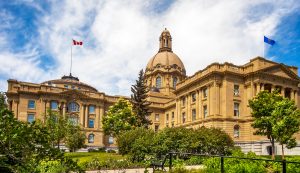Infrastructure funding was a hot topic at the Alberta Municipalities’ (AbMunis) spring meeting with Premier Danielle Smith saying an increased cap means local governments are now true partners with the province.
But AbMunis president Cathy Heron said municipalities are still seeing reduced capital funding and fighting for more support as Albertans prepare to head to the polls on May 29.
The Government of Alberta is transitioning its framework for funding municipalities from the Municipal Sustainability Initiative to the Local Government Fiscal Framework (LGFF).
After advocacy from AbMunis, the United Conservative Party under Smith added a clause that allowed the LGFF to rise and fall with 100 per cent of inflation, removing a previously listed 50 per cent cap. This change directly ties municipal funding to the overall economic status of the province.
“Linking funding to revenues ensures that you are true partners in Alberta’s success and growth,” Smith said to a crowd of more than 350 municipal representatives at the Alberta Municipalities’ 2023 Spring Municipal Leaders’ Caucus in Edmonton.
“Having a good partnership with you is why and how we made changes to our government’s new local government fiscal framework.”
The funding change was directly thanks to municipal advocacy, the premier said.
“The funding shifts were only going to reflect 50 per cent of the revenue changes. But with your input, Minister (of Municipal Affairs, Rebecca) Schulz, recommended to increase that to 100 per cent.”
In a recent interview with the Journal of Commerce, Heron said municipalities are struggling to meet their infrastructure demands due to reduced funding from the province.
At the meeting, Heron called the 100 per cent cap increase on the LGFF a “huge win” for municipalities.
“However, we continue to advocate for increased starting amounts on a per capita basis,” Heron said.
The association leader emphasized that even with a new framework and a boosted cap, funding for municipalities is continuing a downward trend.
“The current plan for the LGFF means municipalities will receive 33 per cent less infrastructure funding than the historical 12-year average under MSI,” she said.
The final funding amounts for municipalities is subject to an ongoing battle with the provincial government and final numbers have not been determined, Heron said.
“We will try to come to an agreement and Rebecca (Schulz) has agreed to be in the room with us as we tell our stories and try to fight for what we think is right,” Heron told her constituents.
“I honestly believe that our allocation formula was principle-based, was sound and it was fair. I will be fighting to keep that top of mind for the minister.”
One municipal constituent asked Smith how she envisions the relationship between municipalities and the province.
“I want us to be partners,” Smith said and then compared the provincial and federal relationship to the municipal and provincial.
“One of the biggest frustrations I have with Ottawa is that they overtax us and take more than they need. Then they trickle money back with a lot of conditions attached. Then we don’t end up seeing the same amount of money returning,” she said, “and yet we do the same thing to our municipalities.”
Smith said she is having discussions with municipal leaders and provincial officials about that situation.
“My hope is that we’d be able to narrow that gap, that we’d be able to see more of those dollars returning to the communities, because I trust that you know what your infrastructure priorities are better than waiting for us to identify those priorities.”
Smith touted further investments into municipalities as a sign of the party’s support for its local leaders.
“Our government is investing more than $2 billion over three years as part of our change to this local government fiscal framework,” she said.
But Heron said municipalities originally asked for $1.7 billion per year and the $722 million figure falls short of closing a $30 billion infrastructure deficit.
Smith highlighted some of the large infrastructure projects the province has committed to as part of the 2023 budget.
“One of the first places we started was the health care system. We’re investing in facilities like a new hospital in Edmonton and the Stollery, the Red Deer Regional Hospital and funding for a North Calgary Airdrie Regional Health Centre.”
The Red Deer hospital project has an estimated cost of $1.8 billion and will add 200 beds to the hospital and provide several new rooms. There is currently no estimated cost for the new Edmonton hospital, which is in early planning stages, while the 2023 budget includes $3 million to start the process for the Airdrie centre.











Recent Comments
comments for this post are closed